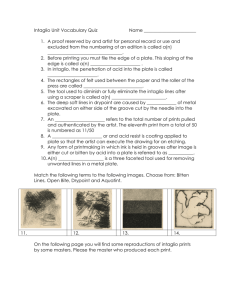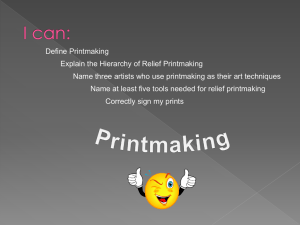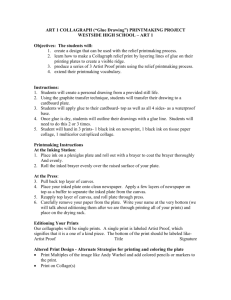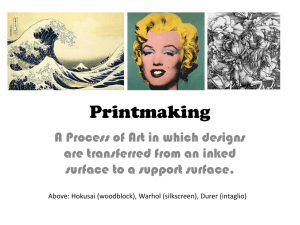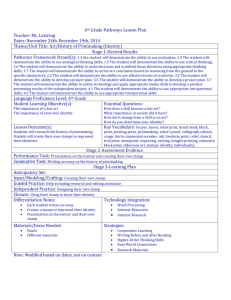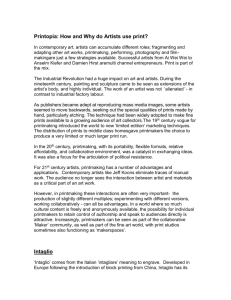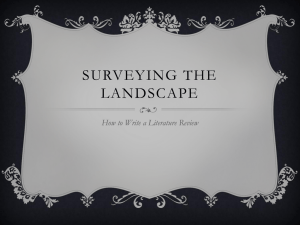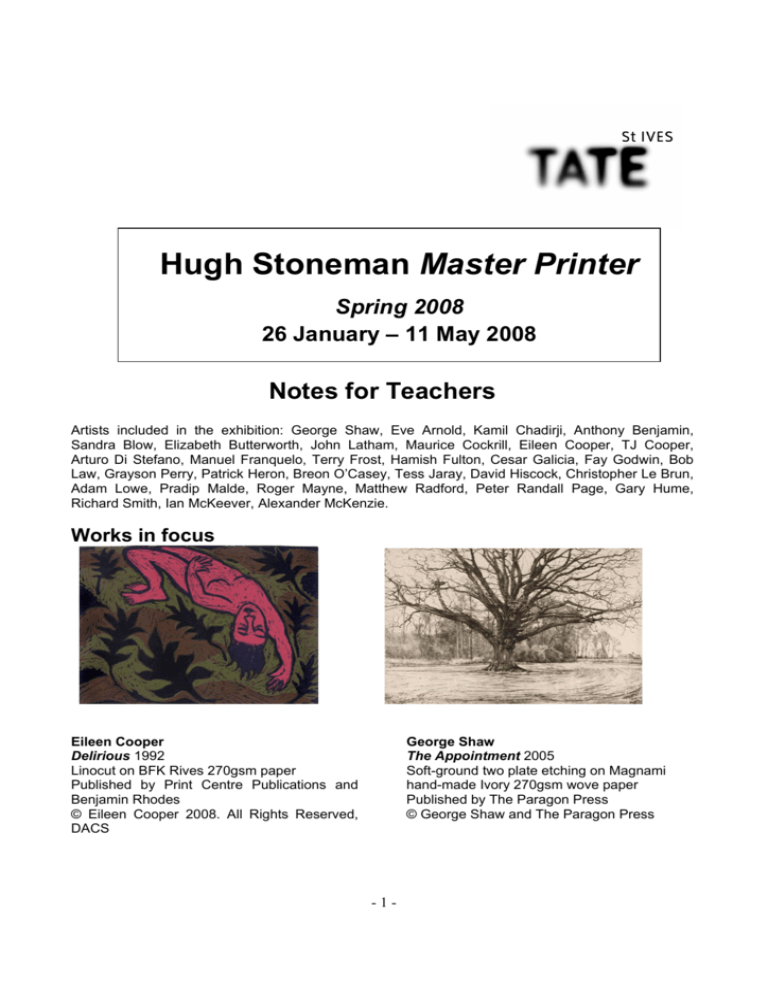
Hugh Stoneman Master Printer
Spring 2008
26 January – 11 May 2008
Notes for Teachers
Artists included in the exhibition: George Shaw, Eve Arnold, Kamil Chadirji, Anthony Benjamin,
Sandra Blow, Elizabeth Butterworth, John Latham, Maurice Cockrill, Eileen Cooper, TJ Cooper,
Arturo Di Stefano, Manuel Franquelo, Terry Frost, Hamish Fulton, Cesar Galicia, Fay Godwin, Bob
Law, Grayson Perry, Patrick Heron, Breon O’Casey, Tess Jaray, David Hiscock, Christopher Le Brun,
Adam Lowe, Pradip Malde, Roger Mayne, Matthew Radford, Peter Randall Page, Gary Hume,
Richard Smith, Ian McKeever, Alexander McKenzie.
Works in focus
George Shaw
The Appointment 2005
Soft-ground two plate etching on Magnami
hand-made Ivory 270gsm wove paper
Published by The Paragon Press
© George Shaw and The Paragon Press
Eileen Cooper
Delirious 1992
Linocut on BFK Rives 270gsm paper
Published by Print Centre Publications and
Benjamin Rhodes
© Eileen Cooper 2008. All Rights Reserved,
DACS
-1-
For discussion
•
•
•
•
•
•
•
•
Look closely at each work. What is the subject or theme of each? Compare and contrast them.
Both these works have been made using printmaking processes. Can you tell just by looking
at them?
These are just two works from an exhibition that is characterised by a diversity of subjects
(source materials) and techniques.
What does this tell us about the master printer who collaborated with each artist to make all
these works?
What does this exhibition say about contemporary printmaking?
What does it tell us about contemporary art?
What does it say about Stoneman’s contribution to contemporary print practice?
The painter Rose Hilton (currently showing at Tate St Ives) also likes to make prints. She
describes the printmaking process as full of mystery. What do you think she means by this?
Note: for information on printmaking techniques please refer to the Glossary
Things to think about
What is an original print? A print is a work that has been created through some sort of reproductive
process. It is generally agreed that an original print is one where the artist and/or printmaker have
influenced and orchestrated the creation of an original work from the making of the matrix (block,
plate etc.) through to the final print. In contrast a reproduction print might be a work that has been
produced by a commercial printer from an existing work as opposed to the creation of a new one.
The master printmaker. What is the role of the master printmaker? Usually it is one that shadows the
artist - they work alongside an artist offering suggestions of techniques in order to achieve the image
the artist seeks. A master printmaker has to subordinate his own personal agenda (and Stoneman did
make his own work) in favour of the artist’s goals. Stoneman described himself as one of the
‘backroom boys’ getting on with the raw materials of the studio. However, it was his extraordinary
attention to detail and his immense craft skills combined with technical innovation that enabled him to
constantly adapt and apply the techniques to suit the needs of different artists. Stoneman encouraged
artists to printmaking processes in creative and original ways. Many who worked with Stoneman have
said that they have come to see printmaking as an integral component of their practice rather than an
adjunct to it.
Artist-printmaker collaborations. The relationship between artist and printmaker has sometimes
been compared to that between a conductor and composer. Stoneman obviously relished the
challenge of working with different artists to realise their vision, whatever the technical obstacles. He
enjoyed this role of facilitator, ensuring that through dialogue with the artist, and through the intrinsic
artistic qualities of the print media, their work found new relationships between image and material.
He had an incredible ability to respond intuitively at each stage of the process, pushing both artist and
medium to a new place. For each new project he would offer total commitment. When asked what
made working with Stoneman special, many artists have said it was the sense that they had his
complete attention. Evidence of all other work was always cleared away in the studio and Stoneman
would immerse himself completely in the current project.
The image. Although he had immense technical ability, for Stoneman a successful print was not
about technique but image. He was constantly pushing the boundaries of traditional printmaking, and
always willing to try new and alternative approaches. His skill lay in his control of the endless
variables, each of which affect the image.
-2-
The fine art of reproduction. Traditionally, printmaking has always taken second place to the ‘fine
art’ of painting and sculpture. An aim of printmaking, of reproduction, has also always been to make
art more affordable. Stoneman turned both these ideas on their head. He has shown how a dialogue
with an artist combined with a deep understanding of the creative qualities of the print media can
result in new relationships between image and material. Stoneman’s studio has developed a whole
new tradition of contemporary fine art based exclusively upon the print medium.
In today’s digital world the boundaries between photography, printmaking and fine art have further
blurred. Printmaking and photography are used as interpretative media and not merely as
reproductive tools.
Edition/ series / repetition / variation. Printmaking offers the potential for both repetition and
variation. Stoneman usually worked to compile portfolios rather than single images with an artist.
Working for a series or edition of prints can open up the potential of the project by allowing an artist to
evolve their work through a variation or theme. This ability to constantly re-work and vary the image,
seems to be the heart of Stoneman’s practice. As Arturo Di Stefano writes, ‘a print was something
that could be tested to destruction, the results of which provided the ground for more images to be
generated in completely unexpected ways’.
Etching. Etching was the first technique that Stoneman perfected and it remained central to his studio
practice. Etching is an intaglio technique in which the image is etched or bitten into a metal plate with
acid. It requires experience and attention to detail to ensure correct registration as well as the intuition
to know how long to immerse the plate in acid and the strength of the ‘wipe’ that determines the tonal
quality. Many artists, including Ian McKeever, Sandra Blow, Arturo Di Stefano, Patrick Heron and
Terry Frost worked with Stoneman to produce etchings.
To watch Hugh Stoneman inking up and then wiping clean a large etching plate was a beautiful sight.
He seemed to know instinctively the density of ink required for each proof and how cleanly it should
be wiped to find the right print. Standing next to him, one could feel the intimacy and love he had for
the activity. He knew when to be emphatic and when to caress, when to leave in or take out with a
single kiss. Ian McKeever
Photogravure. In the 1980s Stoneman perfected the technique of photogravure, an etching process
that allows a photographic image to be reproduced. ‘Gravure’ techniques offer a softness and
elusiveness of image and surface that has appealed to many artists (see for example Fay Godwin’s
illustrations for poems by Ted Hughes). The method known as ‘dustgrain’ where the image is made
on a transparency or film as a ‘positive to positive’ has had particular appeal to some artists because
it allows them to view the image, without it being reversed, throughout the development of the print.
Initially Stoneman learnt photogravure in order to edition a series of photographic negatives of
Baghdad that had been taken in the 1920s and 1930s by Kadil Chadirji. However, further research by
Stoneman and his co-publisher Sara Lee led it to become a distinctive studio technique. His skill drew
photographers such as Eve Arnold and Linda McCartney and artists such as Fay Godwin, David
Hiscock, Hamish Fulton and George Shaw to work with him.
Woodcut. Woodcut is a relief technique whereby a print is made from a plank or block of wood. It
offers a very different kind of process and effect and it is the opposite of intaglio as the surface of the
block is rolled up with ink, the areas not required having been cut away. The grain and texture of the
wood can become part of the surface of the print and this materiality has proved very suitable for
certain artists work. Stoneman was able to run boards through a very large press (4’ x 10,), which
enabled artists such as Terry Frost to work on large woodcut projects.
Stoneman did also work with linocut another relief process but one that contrasts woodcut with its
precision and smoothness. See work by Breon O’Casey, Eileen Cooper and Gary Hume.
-3-
Monoprints. A monoprint is a single and unique print taken from a block or plate and generally run
through a press. As Michael Tooby writes in his catalogue essay ‘monoprints are the apotheosis of
the artist-printmaker collaboration’. Stoneman worked with a number of artists such as Terry Frost,
Lisa Milroy, Richard Smith, Eileen Cooper and Ian McKeever to make large scale monoprints.
Papers. You will notice that the type of paper used for the print is carefully recorded in the label of
each work. The quality and characteristics of the printing paper such as the texture, weight and colour
will affect the image. Choosing the right paper for the right image and printing process is an art in
itself and Stoneman emphasised the importance of using fine art papers.
Publishers. Many of Stoneman’s collaborations were the results of commissions from publishers. For
example, print commissions for the publishers Alan Cristea and Flowers Graphics led to Lisa Milroy,
Richard Smith and Maurice Cockrill working in the studio. Charles Booth-Clibborn’s Paragon Press
has also been instrumental to a number of important commissions such as Patrick Heron’s Brushwork
Series and Terry Frost’s woodcuts.
Contemporary printmaking. Stoneman’s relocation to Cornwall brought to the county an
international resource. His workshop brought with it his long-time collaborators such as Ian McKeever,
Christopher Le Brun, Adam Lowe and Arturo Di Stefano. All these artists were exploring contexts that
had no direct association with Cornwall. Of course, Stoneman did work with a number of well-known
artists associated with the St Ives including Patrick Heron and Terry Frost. He also worked with
locally-based artists such as Breon O’Casey and Michael Porter and his studio provided opportunities
for other local artists to train as assistants.
Tate St Ives print series. Stoneman collaborated with Tate St Ives to produce a series of prints with
exhibiting artists. The collaboration provided a new creative opportunity for these artists but also
made an accessible way for people to collect their work. Proceeds from the prints have in turn helped
to raise funds for the Tate St Ives exhibition and education programme. Artists included in the series
are Terry Frost, David Nash, Alan Davie, Richard Deacon, Karl Weschke, Toby Paterson and Bryan
Pearce.
-4-
Practical ideas
Quick/ simple activities
1. Simple ‘intaglio’ drawings. Drawing with a pointed tool (such as a wooden modelling tool) by
pressing on card or foam board. Make a simple ‘print’ of your drawing by then placing sugar
paper over the top of the card and rubbing with a soft crayon.
2. Magic scratchboards. Use pre-prepared or homemade scratchboards for students to scrape
their own images onto.
3. Simple monoprints & collographs. Create monoprints using found shapes, scraps and
materials which students collage onto a flat surface. A basic version of this can be done in the
gallery by using ready-cut shapes that students place under their paper and rub with a pencil.
Extended projects
1. Introduction to printmaking. Use the exhibition as a starting point for an exploration of
different printmaking techniques (depending on resources available). Students could focus on
one work they like and research the particular techniques used in its creation.
2. Recycling and sourcing images. Explore the range of source material used to create the
prints in the exhibition. Students could develop work by combining both a range of sources
and a range of processes.
3. Print for a politician. Look at Grayson Perry’s work Print for a Politician 2005. Why do you
think Perry gave it this title? This image has been described as a ‘post modern Bayeux
Tapestry’. Invite students to make their own artwork for a politician giving careful thought to
the narrative structure and composition of the work.
-5-
Further research
Hugh Stoneman (1947-2005) was born in Islington, London and studied painting at Camberwell
School of Art in the late 1960s. He then worked at Atelier 17, William Hayter’s studio in Paris, where
he learnt the technique of etching. In 1972 Stoneman set up an open access etching studio in North
London, providing the opportunity for artists to make new work in the medium of print. In 1979 he
moved to Covent Garden to form the Print Centre, offering etching, woodblock, letterpress and
lithography to a wide range of artists. In 1988 he returned to Islington until he relocated, in 1995, to a
purpose built studio at Madron in West Cornwall. At this time he began publishing as Stoneman
Graphics. Today Stoneman Graphics Gallery is run by his widow, Linda.
Hugh Stoneman
Hugh Stoneman Master Printer, Essay by Michael Tooby, Tate St Ives, 2008
www.stonemangraphics.co.uk Stoneman Graphics Ltd.
Contemporary Printmaking
Contemporary British Art in Print, Scottish National Gallery of Modern Art/ Paragon Press, 1995
Lewison, Jeremy & Elliot, Patrick (eds) Contemporary Art in Print: The Publications of Charles BoothClibborn and His Imprint the Paragon Press 1995-2000, 2001
Contemporary Art in Print, The Publication of Charles Booth-Clibborn and his imprint The Paragon
Press, 2001-2006, Paragon Press/ Contemporary Editions, 2006
Printmaking techniques
Dawson, John, The complete Guide to Prints and Printmaking: Techniques and Materials, 1983
Gasgoine, Bamber How to Identify Prints: A Complete Guide to Manual and Mechanical Processes
from Woodcut to Inkjet, 2004
Gilmour, Pat, Artists in Print an Introduction to Prints and Printmaking, 1981
Noyce, Richard, Printmaking at the Edge: 45 Artists: 16 Countries: a New Perspective, 2006
Saunders, Gill & Miles, Rosie, Prints Now: Directions and Definitions, 2006
Simmons, Rosemary, Dictionary of Printmaking Terms, 2002
The Encyclopaedia of Printmaking Techniques, Search Press, 2001
The History of Printmaking, Scolastic Books, 1996
Stobart, Jane, Printmaking for Beginners, 2006
Toale, Bernard, Basic Printmaking Techniques, A Guide for Teachers,1992
//moma.org/exhibition/2001/whatisaprint – Useful teaching resource with information on lithography,
etching, screenprinting and woodcuts. Based on an exhibition at the Museum of Modern Art, New
York.
-6-
Glossary of printmaking terms and techniques
Intaglio Techniques
From an Italian word meaning ‘incised design’, the intaglio ‘family’ includes etching, engraving and
drypoint. Marks, grooves and hollows below the surface of a metal plate form the image. Plates are
inked and the surface wiped clean, leaving ink only in those areas below the surface. The plate is
printed by laying a dampened sheet of paper over it and running it through a press under pressure. It
is this pressure which causes the indentation or ‘platemark’ common to all intaglio techniques. The
softened paper is forced into the incised areas pulling out the ink, thus printing the image. All intaglio
images are reversed when printed.
Etching. An intaglio technique in which the image is etched or bitten into a metal plate with acid. A
metal, usually copper, plate is covered with a protective layer or resist, known as a ground, through
which the image is drawn. The plate is immersed into an acid bath and the exposed copper bitten
away.
Hard ground etching. A wax based acid resist, which is hard when cold, is applied to the surface of
the plate and through which the image is drawn. When etched it gives a pen-like line.
Soft ground etching. A soft, wax based acid resist, which remains soft when cold, is applied to the
plate surface. A sheet of lightweight paper is laid on top and the image is drawn on this. The ground is
pulled into the paper revealing a softer mark on the plate which, when etched gives a pencil-like line.
Aquatint. An etching technique used to introduce tone, rather than line, to an image. Rosin dust is
allowed to settle, adhered by heat to the surface of the plate and then etched. The acid bites around
each tiny grain, forming pools of tone from fine grey to deep black depending on the length of time the
plate is allowed to etch. By alternately etching, painting out chosen areas (with stopping out varnish or
resist) and re-etching the plate, gradations of tone can be achieved.
Sugarlift. An etching technique, which allows the image to be painted directly on to the plate using a
saturated sugar solution. The plate is covered with a resist and then immersed in warm water, floating
off the sugar lift and exposing the copper in those areas. The plate is then aquatinted and etched.
Photogravure. An etching process in which a same size photographic ‘positive’ transparency of the
image is exposed to photosensitised gelatine. When transferred on to a prepared copper plate, the
gelatine acts as an acid resist.
Dustgrain Gravure. A variation of the photogravure process, which implies that the positive image is
hand drawn onto transparent film and that the copper plate is aquatinted during the plate-making
process.
Drypoint. An intaglio technique in which the image is drawn directly into the plate using a sharp
drypoint tool. The resulting incised line has ridges of metal either side, which give the characteristic
rich blurred line.
Carborundum. A technique in which a mix of PVA and carborundum dust are painted on to the
surface of a plate and then inked as an intaglio plate. Its raised texture typically gives a deep tone and
strong emboss into the paper.
Chine Collé. A printing technique in which thin pieces of fine tissue are stuck to the image during the
printing process to introduce colour or tone.
-7-
Relief Techniques
The relief ‘family’ of techniques include woodcut, wood engraving and linocut. The opposite of intaglio,
the surface of the block is rolled up with ink and forms the image. Marks below the surface are not
inked. Areas that are required not to be printed are cut away from the block and the surface rolled up
with ink. Paper is laid on top and the image printed, using a press or by hand. All relief print images
are reversed during the printing process.
Woodcut. A relief print made from a plank or block of wood, sawn along the grain and smoothed.
Often the grain of the wood is evident in the final print
Linocut. A relief technique using linoleum or ‘lino’ as the block from which the image is cut and
printed. Unlike wood, lino traditionally gives a flatter, more homogenous printing surface.
Further Techniques
Monoprint. A single and unique print taken from a block or plate and generally run through a press.
Collage. From the French coller – to glue. An image made up of an assemblage of forms – in
printmaking usually paper, cut and applied to the finished print.
Fine Art Editions
The making of a fine art print usually emerges through a platemaking and proofing process in which
the plate is made and trial or ‘state’ prints proofed until the artist is satisfied with a final print. There is
then a separate process of running off an agreed number, each to the standard of the signed final
proof, this process is known as 'editioning'
Limited Edition. Fine Art prints are published in limited numbers in order to maintain quality and
exclusivity. The total number of prints is known as the edition. Each print is signed by the artist and
numbered, conventionally in pencil, below the image on the print margin. This shows the number of
the print itself over the total number in the edition.
BAT. Bon à Tirer - literally meaning ‘good to pull’ – the print made at the conclusion of the
platemaking and proofing process which is signed by the artist and used as a guide for the rest of the
edition.
AP. Artist’s Proof – a print signed by the artist, usually for their own use.
HC. Hors de Commerce – literally meaning ‘outside commerce’ - a print signed by the artist and
generally for the publishers use.
PP. Printer’s Proof – a print signed by the artist for the studio and printers involved in making or
editioning the image, usually for their own use.
For further definitions of key art terms and movements please refer to the Tate Glossary at
www.tate.org.uk/collection
See also //moma.org/exhibition/2001/whatisaprint – A useful teaching resource with information on
lithography, etching and woodcuts. Based on an exhibition at the Museum of Modern Art, New York.
-8-

